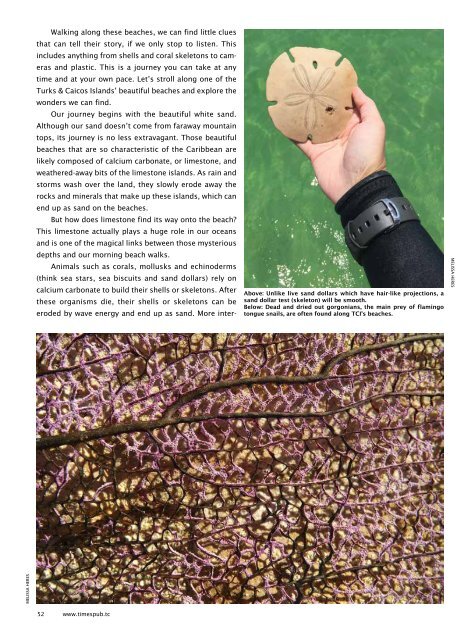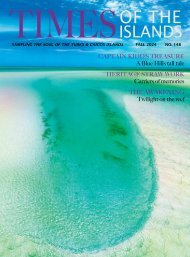Times of the Islands Spring 2021
Presents the "soul of the Turks & Caicos Islands" with in-depth features about local people, culture, history, environment, real estate, businesses, resorts, restaurants and activities.
Presents the "soul of the Turks & Caicos Islands" with in-depth features about local people, culture, history, environment, real estate, businesses, resorts, restaurants and activities.
Create successful ePaper yourself
Turn your PDF publications into a flip-book with our unique Google optimized e-Paper software.
Walking along <strong>the</strong>se beaches, we can find little clues<br />
that can tell <strong>the</strong>ir story, if we only stop to listen. This<br />
includes anything from shells and coral skeletons to cameras<br />
and plastic. This is a journey you can take at any<br />
time and at your own pace. Let’s stroll along one <strong>of</strong> <strong>the</strong><br />
Turks & Caicos <strong>Islands</strong>’ beautiful beaches and explore <strong>the</strong><br />
wonders we can find.<br />
Our journey begins with <strong>the</strong> beautiful white sand.<br />
Although our sand doesn’t come from faraway mountain<br />
tops, its journey is no less extravagant. Those beautiful<br />
beaches that are so characteristic <strong>of</strong> <strong>the</strong> Caribbean are<br />
likely composed <strong>of</strong> calcium carbonate, or limestone, and<br />
wea<strong>the</strong>red-away bits <strong>of</strong> <strong>the</strong> limestone islands. As rain and<br />
storms wash over <strong>the</strong> land, <strong>the</strong>y slowly erode away <strong>the</strong><br />
rocks and minerals that make up <strong>the</strong>se islands, which can<br />
end up as sand on <strong>the</strong> beaches.<br />
But how does limestone find its way onto <strong>the</strong> beach?<br />
This limestone actually plays a huge role in our oceans<br />
and is one <strong>of</strong> <strong>the</strong> magical links between those mysterious<br />
depths and our morning beach walks.<br />
Animals such as corals, mollusks and echinoderms<br />
(think sea stars, sea biscuits and sand dollars) rely on<br />
calcium carbonate to build <strong>the</strong>ir shells or skeletons. After<br />
<strong>the</strong>se organisms die, <strong>the</strong>ir shells or skeletons can be<br />
eroded by wave energy and end up as sand. More inter-<br />
Above: Unlike live sand dollars which have hair-like projections, a<br />
sand dollar test (skeleton) will be smooth.<br />
Below: Dead and dried out gorgonians, <strong>the</strong> main prey <strong>of</strong> flamingo<br />
tongue snails, are <strong>of</strong>ten found along TCI’s beaches.<br />
MELISSA HERES<br />
MELISSA HERES<br />
52 www.timespub.tc

















